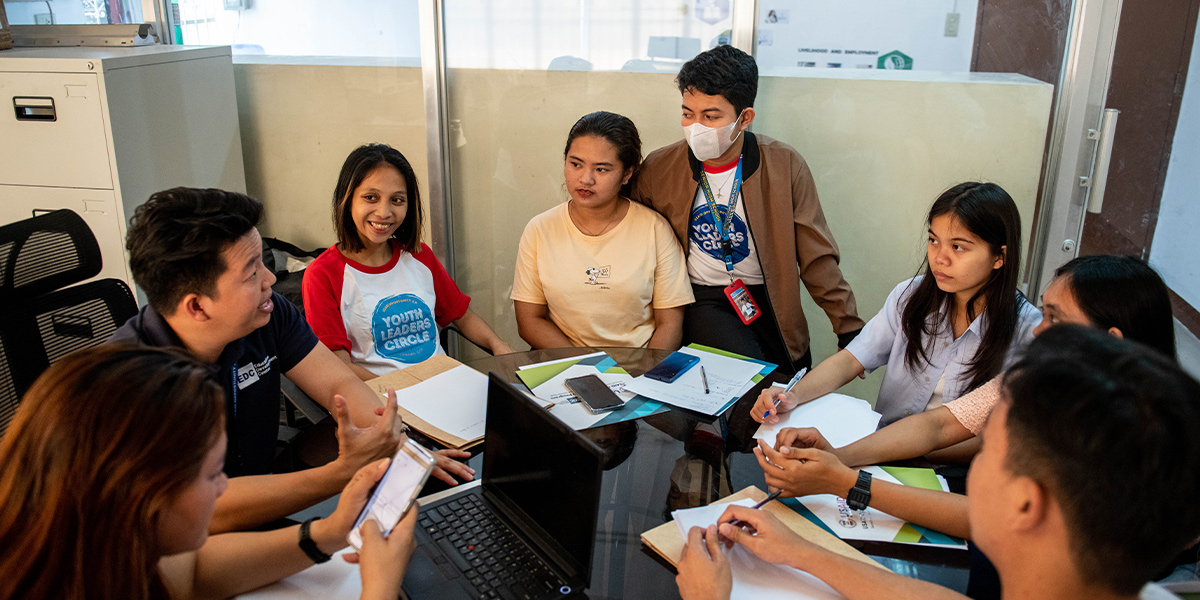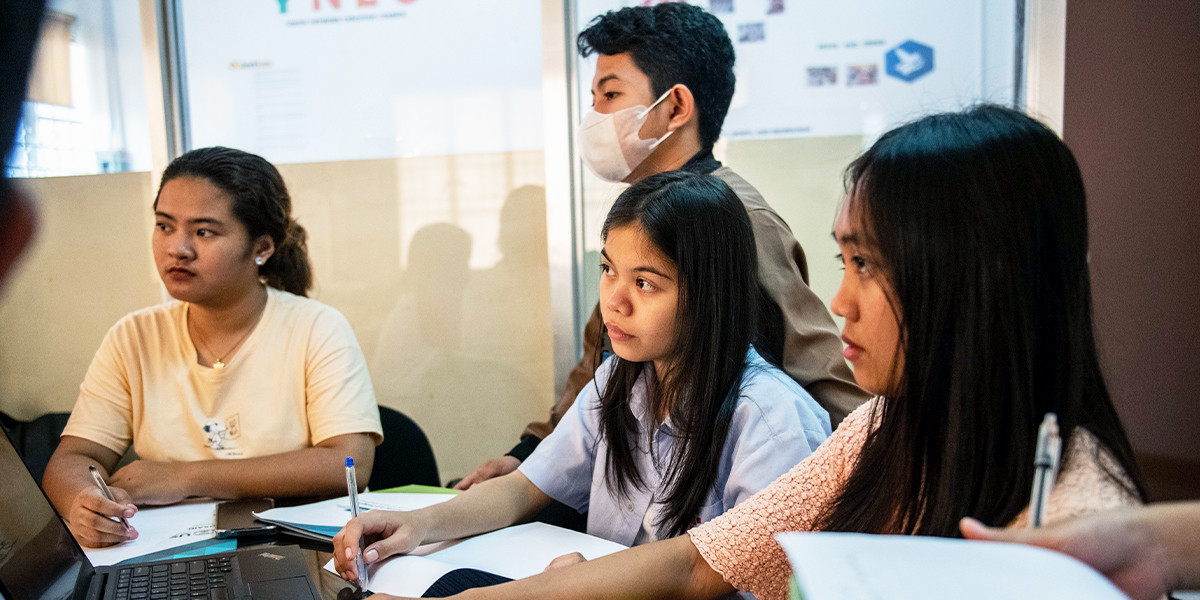The Future of Work Is Here: Part 2 – Today’s Skills Are Not Enough

At EDC, our goal is for youth and adults to be able to access relevant education and opportunities that prepare them to participate in the current economic landscape and to lead in future innovations. Building on our decades of experience in work readiness skills development in 28 countries, EDC seized upon this transformational moment to revisit the job skills that youth need for today and tomorrow.
Workforce development experts at EDC conducted a deep-dive global desk review of the current in-demand skills and the methods for developing those skills.1 We reviewed current and projected skills needs shared by employers, including reports prepared by organizations such as the World Economic Forum, the International Labour Organization, and the Organisation for Economic Co-operation and Development (OECD). We balanced this review with supply-side reports by Coursera, which provided regional snapshots of the most in-demand skills sought after by students.
Many of today’s students will work in jobs that do not yet exist, most of which are likely to have an increased reliance on both digital and social-emotional skills.2 To flourish and grow in today’s—and tomorrow’s—world of work, technical skills must be combined with soft skills, such as “creativity, complex problem solving, relationship building, communication, emotional intelligence, and critical thinking.”3 Employers also cited a need for employees who could analyze data to inform decision-making.
Some of these skills are not new, and they will continue to endure, for example, the ability to communicate well. However, our research revealed an emphasis on employees being able to solve difficult, complex problems, especially those requiring creativity, and to collaborate across multidisciplinary teams, especially remotely. Underlying all of this is the recognition that workers will continue to need to learn on the job and re-skill and that continuous lifelong learning is critical.
The in-demand skills that employers across the globe most commonly expressed a need for are grouped into the following skill clusters:
- Resilience, flexibility, and continuous learning
- Creativity and innovation
- Digital skills
- Communication and collaboration
- Critical thinking
- Navigating career pathways
- Adaptive skills for sustainable economies
- Cross-cultural leadership skills
The research also showed that how people learn is as important as what they learn. Although lecture is still the preferred method of instruction in most secondary and postsecondary educational settings, research indicates that this method yields low rates of student retention.4 In contrast, evidence suggests effective learning outcomes are associated with the following methods:
- Project-based and experiential learning5,6,7,8,9
- Instructors in the role of facilitators (rather than lecturers)10,11
- Students working collaboratively in teams12,13
- Technology integrated into learning14,15
- Work-based learning16,17 and business exposure18,11
Students should also have a degree of choice in the learning (e.g., which digital skill to learn or what project to undertake), which develops self-directed learning skills that will serve them in the long term. Although these methods have been introduced to classrooms globally, their application has been uneven.
Our research also found that skills development programs that develop meaningful partnerships with employers are often the most successful in aligning young job seekers with market needs. These linkages often lead to youth being able to strengthen their academic degrees with complementary industry certifications that ready them for almost immediate employment in high-demand jobs. And the benefits extend to employers too, reducing recruitment costs and increasing employee retention, employee morale, and innovation.
In Part 3 of this series, we will share how EDC responded to this call for upskilling through our new Future Proof Skills curriculum.
Nancy Chervin is an international education and workforce advisor specializing in workforce readiness, market connections, and work-based learning. She focuses on the rapidly changing world of work through youth skills development and connecting educational institutions with employers.
1This desk review encompassed 25 recent future-of-work reports as well as employer surveys of in-demand skills across multiple sectors and countries.
2An estimated 65% of children entering primary school today ultimately will end up working in completely new job types that do not yet exist. Refer to: World Economic Forum. (2016). The future of jobs: Employment, skills and workforce strategy for the fourth industrial revolution. https://www3.weforum.org/docs/WEF_Future_of_Jobs.pdf
3Deloitte, & Global Business Coalition for Education. (2018, September 14). Preparing tomorrow’s workforce for the fourth industrial revolution: For business: A framework for action. https://www.deloitte.com/global/en/issues/work/gx-preparing-tomorrow-workforce-for-the-fourth-industrial-revolution.html
4Research by David W. Johnson and Roger T. Johnson of the University of Minnesota has demonstrated that cooperative learning methods, which emphasize active student participation and collaboration, enhance student engagement and retention. Their work suggests that traditional lecture-based instruction, which often lacks interactive elements, may be less effective in promoting long-term retention and understanding. See: Johnson, D., & Johnson, R. (1988). Learning together and alone. Prentice Hall; Johnson, D., & Johnson, R. (2008). Active learning: Cooperation in the classroom. Annual Report of Educational Psychology in Japan, 47, 29–30. https://doi.org/10.5926/arepj1962.47.0_29
5Holm, M. (2011). Project-based instruction: A review of the literature on effectiveness in prekindergarten through 12th grade classrooms. Rivier Academic Journal, 7 (2).
6Edutopia. (2007, October 19). Why is project-based learning important? http://www.edutopia.org/project-based-learning-guide-importance
7World Economic Forum. (2020, January). Schools of the future: Defining new models of education for the fourth industrial revolution. https://www3.weforum.org/docs/WEF_Schools_of_the_Future_Report_2019.pdf
8Deloitte and Global Business Coalition for Education, Preparing tomorrow’s workforce.
9Accenture (2017). New skills now: Inclusion in the digital economy. https://www.workforceprofessionals.org/wp-content/uploads/2020/01/Accenture-New-Skills-Now-Inclusion-in-the-digital.pdf
10Care, E. & Kim, H. (2018). The explicit nature of educational goals for the twenty first century. In C. Wyatt-Smith & L. Adie (eds.), Innovation and accountability in teacher education, as cited in Lego Foundation (2021). Position Paper: Closing the Skills Gap.
11World Economic Forum, Schools of the future.
12World Economic Forum, Schools of the future.
13Deloitte and Global Business Coalition for Education, Preparing tomorrow’s workforce.
14World Economic Forum, Schools of the future.
15LinkedIn Learning, (2021). LinkedIn Learning’s 5th annual workplace learning report 2021 / Skill building in the new world of work. https://learning.linkedin.com/content/dam/me/business/en-us/amp/learning-solutions/images/wlr21/pdf/LinkedIn-Learning_Workplace-Learning-Report-2021-EN-1.pdf
16Organisation for Economic Co-operation and Development. (2020). Dream jobs? Teenagers’ career aspirations and the future of work.
17Deloitte and Global Business Coalition for Education (2018). https://www.oecd.org/en/about/projects/career-readiness.html?appId=aemshell
18Organisation for Economic Co-operation and Development, Dream jobs?
19Youth Power Action, & U.S. Agency for International Development. (2020). Private sector engagement in workforce development programming: Why it matters. https://www.edu-links.org/resources/why-private-sector-engagement-workforce-development-programming-matters






